Coffee imported by sail
Decarbonizing coffee as much as possible: that's the mission Javry has set itself. This time, we're tackling transport, and will soon be importing 4 coffees by sailing cargo ships.
Why shipping goods by cargo sailboats?

Most carbon-free transport
A sailing cargo ships produces 90% less CO2 than a conventional container ship on the same route. It is the most carbon-free form of transport to date.

Responsible energy
Wind is an inexhaustible, abundant and predictable source of energy.

Protected quality
The coffee is transported in dedicated holds, guaranteeing the ideal temperature and condensation rate for its preservation.
Our coffees imported by cargo sailboats
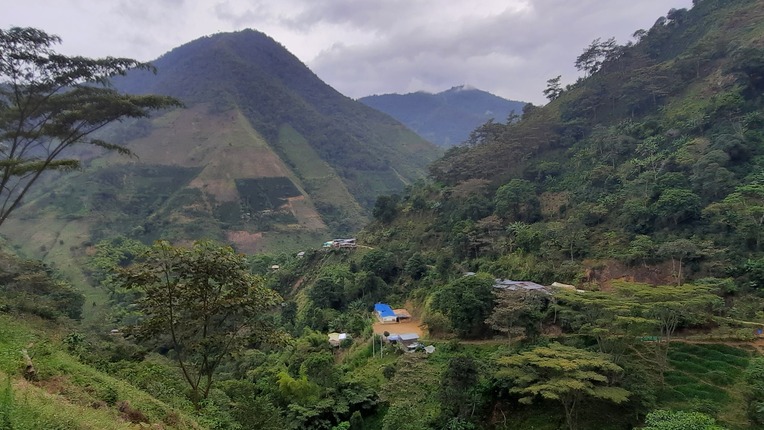
Granja Fabrica
This high-altitude organic coffee comes from ancient varieties. Grown by 240 indigenous families on protected terroirs, this coffee reflects the ecological commitment of these communities, offering one of the finest coffees in Colombia.
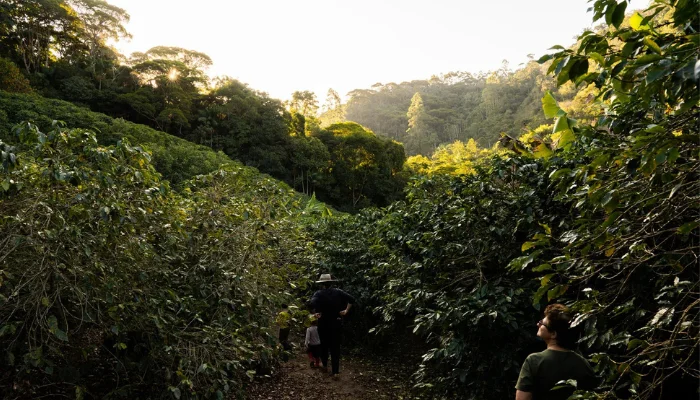
Mosaico
This beautiful Brazilian coffee is cultivated in the Espirito Santo region, recognized for its high quality coffee production, thanks to its hilly landscape. The producers of the Mosaico are extremely careful to respect the environment and pick the coffee cherries by hand.
AVAILABLE IN FEBRUARY 2025

Casal
The Casal is a must for espresso lovers! This rich blend is 100% Brazilian and 100% imported by sailboat. This blend associates a beautiful Arabica and a strong Robusta.
AVAILABLE IN FEBRUARY 2025
The impact of transport
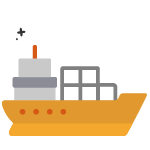
Conventional transport
Travel time
30 to 45 days
Impact on quality
Overheating of goods and water leakage into containers
CO2 impact of journey
20g of CO2 emitted per km and per tonne
Impact on the oceans
- Noise pollution
- Acidification
- Ocean eutrophication

Sailing transport
Travel time
20 days on average
Impact on quality
Transport in dedicated, environmentally-controlled holds
CO2 impact of journey
2g of CO2 emitted per km and per tonne
Impact on the oceans
None🐋💙
Step by step
2022: first schooner crossing
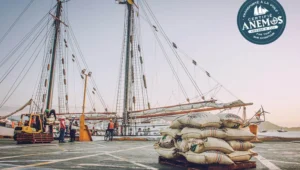
Very early on, we took up the challenge of transporting our coffee by sail. At the time, it cost us €5 per kilo of coffee: an aberration when you consider that conventional freight costs €0.24 per kilo. But we believe in this solution, and the initial investment is necessary to test the solution and get things moving.
This first boat is a century-old schooner.
2023: Construction of the cargo sailboat
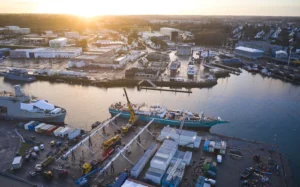
After these first successful crossings, TOWT, the company engineering the boats, is stepping up a gear with the construction of a sailing cargo ship that can carry up to 1100 tonnes of goods.
We are following its construction closely.
August 2024: first crossing of the sailing cargo ship
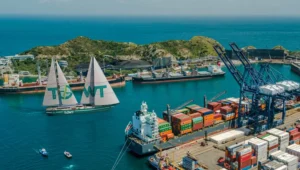
The sailing cargo ship left the port of Santa Marta in northern Colombia in August. On board were bags of Granja Fabrica, produced in the Tolima region.
This time, transport cost us €1 per kilo, 5 times less than in 2022.
September 2024: Arrival of coffee at the port of Le Havre
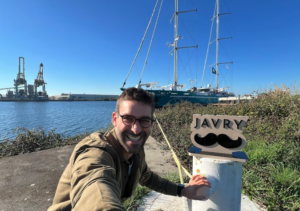
The Granja Fabrica arrived in the port of Le Havre in September, where we were impatiently waiting for it! It then got roasted by Migüel, in the Ardennes.
October 2024: Arrival in your cups
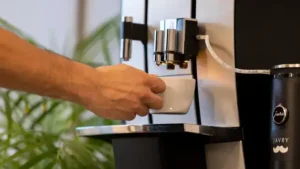
Your freshly roasted coffee arrived in your cups after its long journey.
2025: Expansion of our sailing range
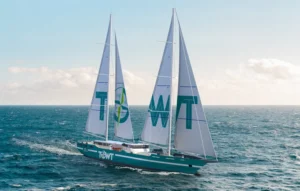
In 2025, we expand our “imported by sail” range to 3 delicious coffee from South America.
Frequently asked questions
What's the problem with traditional cargo shipping?
Let’s take a moment to go into the details. Firstly, to protect the environment:
- CO2 emissions : In terms of strictly CO2 impact per tonne per km, sea freight is often described as the most efficient means of transport. And that’s not counting the other major impacts.
- Heavy fuel oil Vessels consume heavy fuel oil, a by-product of oil refining. It’s a highly viscous fuel, whose incomplete combustion (black smoke) generates over 20% of nitrogen dioxide and sulfur emissions (acid rain, cardio-respiratory diseases, eutrophication of maritime areas), and is a major contributor to black carbon emissions (a thin black film that blackens buildings in polluted cities). A container carrier consumes 200,000 L of heavy fuel oil per day.
- Noise pollution The noise level of shipping traffic is between 170 and 190 dB, almost 2 times higher than the level permitted in nightclubs (102 dB), triggering physiological reactions and behavioral changes in marine species. Source : NDRC.com
- Impact on biodiversity Ship ballasting (water pumped into bunkers to stabilize huge ships) is a vector for the transfer and spread of threatening invasive species from one part of the world to another.
- Waste emissionWaste: According to the World Shipping Council, an estimated 1,566 containers are lost at sea every year, becoming a hazard to shipping, not to mention the amount of waste floating on the surface or sinking to the bottom of the oceans.
- The cost of a tonne of CO2 (the famous carbon tax) rose from 30 euros in February 2021, to 80 euros in July 2023, reaching 100 euros in March 2023, a 3-fold increase. The carbon quota system has been extended to maritime transport since this summer. All it would take is for this amount to be multiplied by 2 again, to 200 euros per tonne, and the cost of sailing would become less expensive than its carbon equivalent. The price of transport has an impact on the final price of the product for consumers. So we’re looking for the best way to continue offering ethical, eco-responsible coffee at a fair price.
Are sailing cargo ships completely carbon-free?
No. It would be dishonest to say that the sailing cargo ship has zero carbon emissions. However, it is the most carbon-free means of transport to date. That’s why we’re committed to the project.
The construction of the sailing cargo ship has a carbon impact of 1,800 tonnes over a 25-year lifespan. A conventional container ship emits 90,000 tonnes in its construction, also over a 25-year lifespan.
On average, over the entire life cycle of these two types of boats and on a route similar to that from Santa Marta to the port of Le Havre :
- A container ship will emit 80g of CO2 per kilogram of cargo transported.
- The sailing cargo ship will emit 13gr of CO2 per kilo of cargo transported`.
How long does a crossing take?
On a sailing cargo ship, it averages 20 days. The sailing cargo ship makes a direct journey from the port of departure to the port of arrival.
With a conventional container ship, it takes between 35 and 40 days. To be profitable, the container ship has to pass through several ports, and therefore takes longer despite its faster speed.
The length of the journey has an impact on the freshness of the coffee. The faster, the better.
What happens if there's no wind?
- The boat is equipped with routing software, the aim of which is to optimize the yacht’s route in search of favourable winds. This software allows you to choose the best crossing.
- If the route takes you through windless areas, you’ll have to use the engine to get to the starting port on time.
- According to wind statistics for the last 20 years, the wind is stable.
Does a cargo sailboat still have an engine? If so, what type of motor is it and why do you need one?
- Yes, there are 2 diesel engines.
- It’s compulsory to have one on sailboats, and even more so on freighters! The boat moves in and out of harbors by motor.
What else are you doing to make coffee more sustainable?
- Sourcing We work directly with coffee growers and establish long-term relationships. They are paid fairly for their work.
More information about sourcing at Javry →. - Farming techniques Sustainable agriculture: our producers are committed to sustainable agriculture. 50% of our coffee is organically grown and certified BIO by Certicys.
- Packaging : our packaging is eco-responsible.
- Circular economy: we give coffee machines a second life.
- Day-to-day corporate life: we carry out a carbon assessment of our company with the Tapio team, which enables us to identify our impact and set concrete targets for reducing it.
Discover our ecological commitments →





